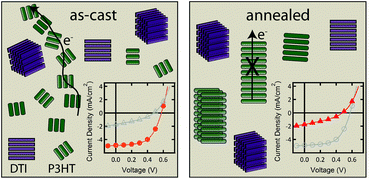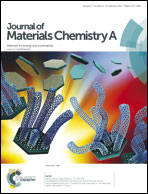Linking morphology and performance of organic solar cells based on decacyclene triimide acceptors†
Abstract
Bulk heterojunction photovoltaic devices consisting of a novel non-fullerene acceptor based on a decacyclene triimide core and the common polymer donor poly(3-hexylthiophene) exhibit good power conversion efficiency (∼1.6%) as-cast. However, thermal annealing results in a drastic decrease in both the efficiency and the electron current. Polarized soft X-ray spectroscopy and grazing incidence X-ray scattering reveal that thermal annealing results in a reorientation of the acceptor molecules to an edge-on orientation with their π–π stacking direction predominantly in-plane with the substrate and overall hexagonal packing among planar columnar structures. This packing motif greatly hinders vertical electron transport in bulk heterojunction films. Furthermore, in situ X-ray scattering studies show that this critical reorientation occurs even at relatively low temperatures (∼60 °C). These results are some of the first to highlight differences between the morphology of non-fullerene and fullerene-based bulk heterojunctions and critical parameters that must be controlled when designing future high-performance non-fullerene acceptor molecules.


 Please wait while we load your content...
Please wait while we load your content...